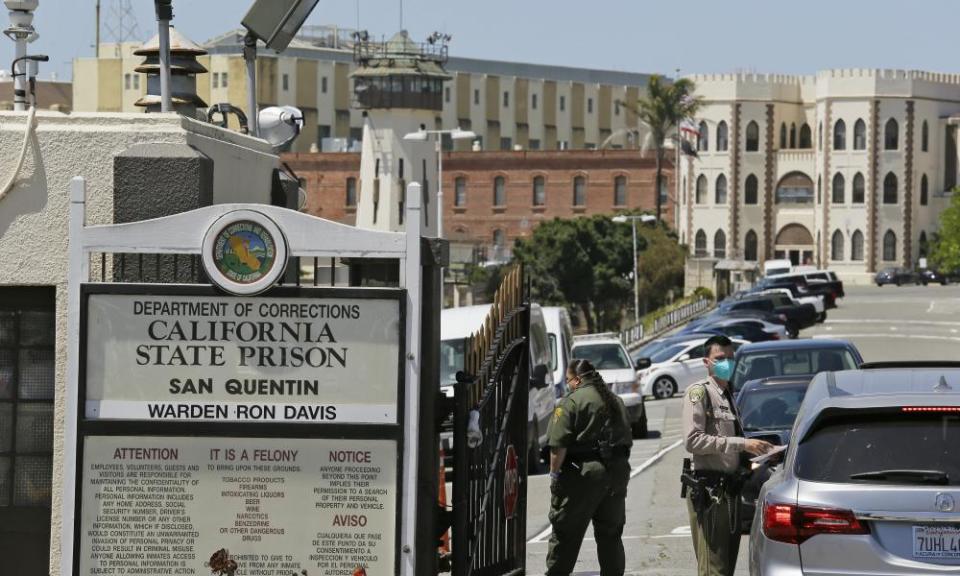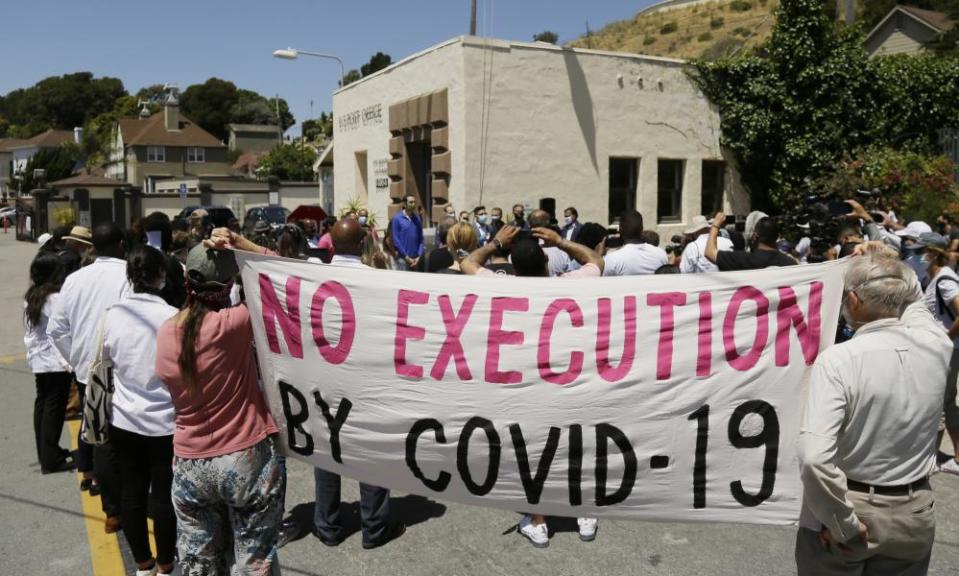California must cut San Quentin prison population amid pandemic, court rules

A California court has ordered state corrections officials to cut the population of the state’s oldest prison to less than half of its designed capacity, citing officials’ “deliberate indifference” to the plight of prisoners during the coronavirus pandemic.
State prison officials said Wednesday that they are deciding whether to appeal against the order, which otherwise will force them to parole or transfer about 1,100 inmates serving time in San Quentin state prison in the San Francisco Bay Area.
Related: Act now or coronavirus will sentence more prisoners to death, say experts
San Quentin was the site of one of the nation’s worst coronavirus outbreaks. At least 28 inmates have died of the virus, and 2,200 or about 75% of the prison population were infected at the peak of the outbreak. Nearly 300 employees were sickened and one died.
The outbreak at the facility was “the worst epidemiological disaster in California correctional history”, the first district court of appeal in San Francisco said in Tuesday’s ruling.
The three-justice court said officials’ decision not to cut the inmate population by half, as recommended by prison officials’ outside advisers in June, was “morally indefensible and constitutionally untenable”.
Assemblyman Marc Levine, a Democrat who represents the area, said that without a further significant reduction, “it is not a question of if another Covid-19 spike will happen at San Quentin, it is a question of when”.
It is not a question of if another Covid-19 spike will happen at San Quentin, it is a question of when
Assemblyman Marc Levine
However, there is only one current active coronavirus case at San Quentin, and two other California prisons now top it for both active cases and cumulative number of infections. Avenal state prison in the Central Valley saw a resurgence of infections in September after cases dropped in July. Folsom state prison near Sacramento didn’t report a positive case until August, but within weeks cases jumped and reached a peak of more than 600 infections.
San Quentin’s outbreak flared when prison officials botched the transfer of prisoners from a southern California prison in May. San Quentin had zero cases before more than 100 new inmates arrived. Within three weeks, 500 people tested positive for the virus. The rapid spread sparked outcry from public health experts, attorneys and activists, who demanded that prison officials and the state’s governor, Gavin Newsom, grant the release of ageing and medically vulnerable people in the prison population.
Cases exploded, driven by “the unique architecture and age” of the prison that opened in 1852, and its “exceedingly poor ventilation, extraordinarily close living quarters and inadequate sanitation”, wrote experts at the University of California, Berkeley School of Public Health and the University of California, San Francisco.
The prison then housed more than 3,500 inmates, many with multiple health vulnerabilities, the experts found. Cutting the population by half would allow many inmates to be housed separately and let officials clear more space to keep inmates spaced for treatment, quarantine or to reduce the virus’ spread, they said.

The three appellate justices said the state failed to present any evidence to the contrary. Their unanimous order requires prison officials to house no more than 1,775 inmates in space designed for about 3,100 inmates and a staffed capacity of nearly 4,500 inmates. The population can be reduced by transfers to other prisons or paroles, the court said. State prisons now hold fewer than 98,000 inmates, so those from San Quentin could probably be absorbed elsewhere, the court said.
Only about 700 San Quentin inmates could not be considered for release, the court said, because they can never be paroled or are on the nation’s largest death row.
“It’s a monumental decision and it is the right decision and it supports our contention that people in San Quentin’s right to be free from cruel and unusual punishment has been violated since the start of the outbreak,” said Danica Rodarmel, the state policy director for the San Francisco public defender’s office.
Her office and others next month are asking a judge in Marin county, home to San Quentin, to free more than 300 of the prison’s inmates on similar legal grounds. Lawyers in those cases also are arguing that the prison’s population must be reduced at least 50%, but say releases – not transfers – are the answer because botched transfers “caused this problem to begin with”, Rodarmel said.
State officials “respectfully disagree with the court’s determination”, the corrections department spokeswoman Dana Simas said in an email, saying the department “has taken extensive actions to respond to the Covid-19 pandemic”.
The department has released more than 21,000 people since March through earlier releases or because they finished their sentences, “resulting in the lowest prison population in decades”, she said. San Quentin’s population was trimmed to the current roughly 2,900 inmates.
Still, the court finds that the “severe limits” on who is eligible for expedited release won’t “result in substantial population reduction at San Quentin”, according to the court. The state’s initiatives only apply to those with nonviolent felonies and 180 days or less on their sentences. This means that “virtually all” of the people, currently serving life sentences are excluded. As of 2019, lifers made up more than a third of San Quentin’s population, according to the filing. The court says if this group is left out of release efforts because of their convictions, the 50% drop will be impossible.
Current inmate coronavirus cases “are the lowest they have been since May”, Simas said, with fewer than 500 current infections and more than 14,000 recovered. Statewide, 71 inmates and 10 employees have died.
The justices’ sweeping ruling came in lawsuit by a 64-year-old San Quentin inmate Ivan Von Staich, who is serving 17 years to life for second-degree murder on top of a 13-year sentence for attempted murder.
He was housed with a 65-year-old inmate in a cell “so small that you can touch the walls with your hands”, where both tested positive for the virus. The court ordered him removed from the prison, noting that he has already been accepted at a residential facility supervised by the corrections system.

 Yahoo Finance
Yahoo Finance 